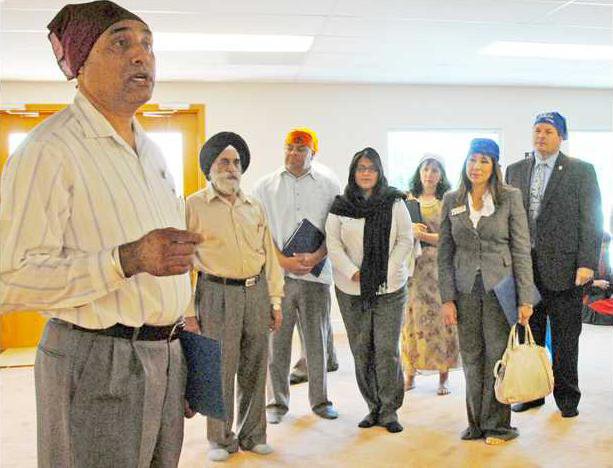Since the early 1900s, followers of the Sikh religion have called California home.
Yet many Americans don’t understand the traditions of the Sikhs. They’re confused as Muslim because of their turbans, or Hindu because of their Indian appearance.
Those misunderstandings have sometimes led to bloody persecution. At other times, the discrimination is more subtle.
But it all stems from a lack of awareness, according to Harinder Grewal, Turlock Unified School District trustee and a Sikh community leader. On Sunday, Grewal invited mayors, school officials, and county officials to tour the Sikh Temple in Turlock, and to learn a bit more about the religion.
“My goal is to reach out to leaders, to reach out to other communities and help them understand who we are,” Grewal said.
Mistaken identities
The Sikh religion, based in the Punjab region of Northwest India, believes in one god. Sikhs believe in equality for all – regardless of race, sex, social status, or religion – to the extent that one Sikh guru was martyred for his support of Hindus.
Followers are asked to work hard, to share with others, and to remember God. And Sikhs are also asked to maintain a unique identity, with an uncut beard, a turban, and other religious items. The unique appearance meant to make Sikhs instantly recognizable, so all might know who they can turn to in a time of need.
“I can’t be a Sikh without a turban,” said Satbir Singh, of the Sikh Coalition. “It is part of our identity.”
Though nearly all turban-wearing Americans are Sikh, misconceptions led to widespread persecution in the days following 9/11.
“The first fatality after 9/11 was Sikh, and it hurts,” Grewal said. “Really hurts.”
A Sikh-American gas station owner in Mesa, Ariz. was shot five times and killed on Sept. 15, 2001, because his killer thought he was an Arab. The killer reportedly made claims of his patriotism as he was arrested, though the Sikh man had brought doughnuts and bagels to area firefighters daily.
That incident and others like it led to a newfound devotion in the Sikh community to educate others about Sikhism and its long roots in America.
“Ten years, 11 years later, the work is not even 1 percent done,” said Nirvair Singh, of the Sikh Coalition.
An education in progress
The work continued Sunday as leaders toured the Sikh Temple.
The leaders dined on traditional fare, heard a presentation on Sikhism, visited a Punjabi school where children are taught the region’s language, and spoke before an assembly of Sikhs.
Grewal said he hoped the day would help build better relationships within the community, while clearing up the misconceptions that have dogged the religion. For Riverbank Mayor Virginia Madueno, the event was a success.
“I can tell you that I did come probably with a lot of misconceptions about the Sikh community,” Madueno said. “… It really makes me feel good that we are now not only welcomed, but we’re being encouraged to learn more about the Sikh community.”
The effort will continue as Sikh leaders try to extend the reach of their educational efforts.
Grewal recently spearheaded an effort to bring the Punjabi language to TUSD high schools, which failed to earn enough interested students. And work is ongoing at a statewide level to add basic points about Sikhism to school standards, just as other religious history is covered.
But for now, Grewal said he was happy that the region’s leaders had made that first step into the Sikh Temple.
“They know a little more about us now than they did before they walked in,” Grewal said.









